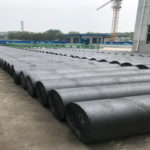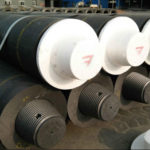Graphite electrodes are essential components in many industrial applications, including steelmaking, aluminum smelting, and other high-temperature processes. These electrodes are designed to withstand extreme heat and high electrical currents, making them critical for the efficient functioning of various industrial processes. However, to achieve optimal performance, graphite electrodes must be equipped with high-quality electrode nipples.

Why Electrode Nipples Are Crucial for Efficient Graphite Electrode Performance?
An electrode nipple is a small threaded connector that attaches the graphite electrode to the power supply. Although it may seem like a small and insignificant component, the nipple plays a crucial role in the performance of the graphite electrode. Here are some reasons why electrode nipples are so crucial for efficient graphite electrode performance:
Efficient Power Transfer
The primary function of the electrode nipple is to facilitate the transfer of electrical power from the power supply to the graphite electrode. The nipple must be made of high-quality material and precisely machined to ensure optimal conductivity and minimize resistance. Any inefficiencies in the transfer of electrical power can lead to decreased performance and increased energy consumption.
Resistance to Thermal Shock
Graphite electrodes are subjected to extreme heat during industrial processes, and they must be able to withstand thermal shock without cracking or breaking. The electrode nipple must be able to handle these same conditions without degrading or breaking apart. A high-quality electrode nipple is made of materials that can withstand high temperatures and thermal shock, ensuring the reliable and consistent performance of the graphite electrode.
Minimizing Nipple Erosion
The nipple is also responsible for distributing electrical power evenly across the surface of the graphite electrode. If the nipple is poorly designed or made of low-quality material, it can lead to uneven distribution of power, causing erosion and deformation of the nipple. Over time, this can lead to decreased performance of the electrode and increased downtime for maintenance and repairs.
Stability and Durability
The nipple must be able to withstand the mechanical stresses of the electrode and remain stable during operation. If the nipple is not sturdy enough, it can become loose or break, leading to reduced performance and potential safety hazards. A high-quality electrode nipple is designed to be stable, durable, and long-lasting, ensuring that the graphite electrode performs consistently and reliably over time.
In conclusion, the electrode nipple is a crucial component for efficient graphite electrode performance. It facilitates the transfer of electrical power, withstands thermal shock, distributes power evenly, and provides stability and durability. Choosing high-quality electrode nipples is essential to ensure optimal performance, reduced downtime, and increased safety in industrial processes that rely on graphite electrodes.

How to Choose the Right Graphite Electrode Nipple for Your Application
Choosing the right graphite electrode nipple is critical for the efficient performance of various industrial processes. However, with so many different types of electrode nipples available on the market, it can be challenging to know which one is the best fit for your application. In this blog post, we will provide a step-by-step guide on how to choose the right graphite electrode nipple for your specific application.
Step 1: Determine the Electrical Requirements
The first step in choosing the right graphite electrode nipple is to determine the electrical requirements of your application. You should consider the voltage and amperage required for your process, as well as the frequency of use of graphite electrodes. This information will help you identify the materials that are most suitable for your application.
Step 2: Consider the Temperature Range
Next, you should consider the temperature range of your process. Different electrode nipples are designed to withstand different temperature ranges, and it is important to choose an electrode nipple that can withstand the specific temperature range of your application.
Step 3: Check the Compatibility
The electrode nipple must be compatible with both the graphite electrode and the power supply. You should check the specific requirements of your application and choose an electrode nipple with the appropriate size, shape, and thread compatibility.
Step 4: Consider the Shape and Design
Finally, you should consider the shape and design of the electrode nipple. Some electrode nipples are designed with a preset nipple, which can help ensure consistent performance and reduce the risk of nipple wear and tear. Others may have a specific shape or design to improve heat distribution or reduce erosion. Namely, Size and Thread Compatibility. Choosing the right size and thread compatibility for the electrode nipple is essential to ensure that it can be securely attached to the graphite electrode and the power supply. It is important to check the specific requirements of your application and choose an electrode nipple with the appropriate size and thread compatibility.
In conclusion, choosing the right graphite electrode nipple for your application requires careful consideration of several factors, including electrical requirements, temperature range, material options, compatibility, and shape and design. By following these steps, you can ensure that you select the best electrode nipple for your specific application, resulting in optimal performance, reduced downtime, and increased safety.









